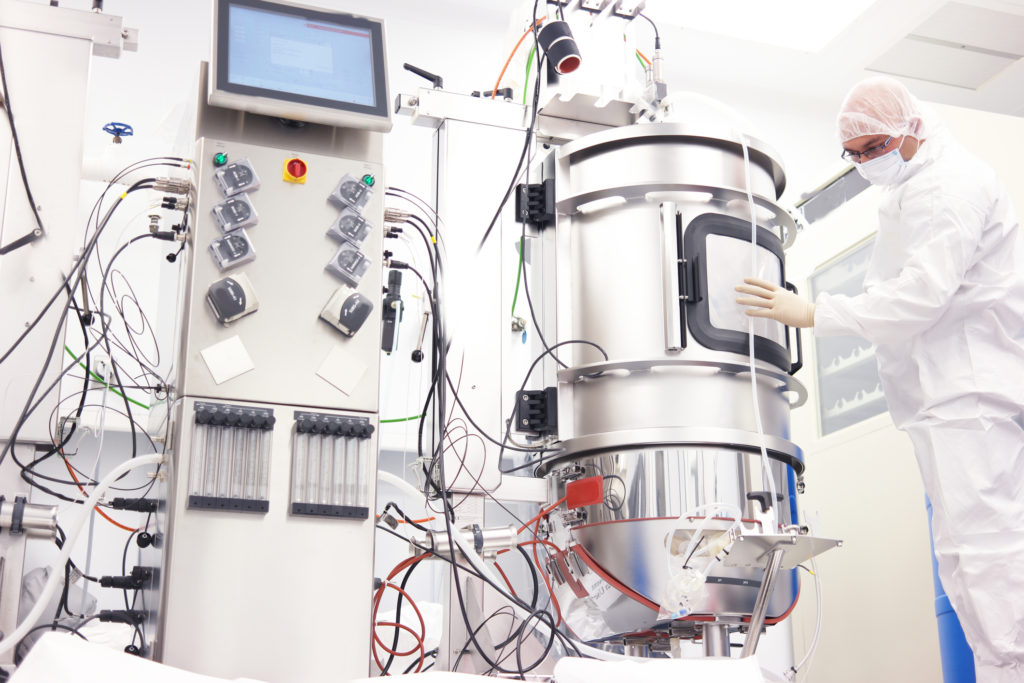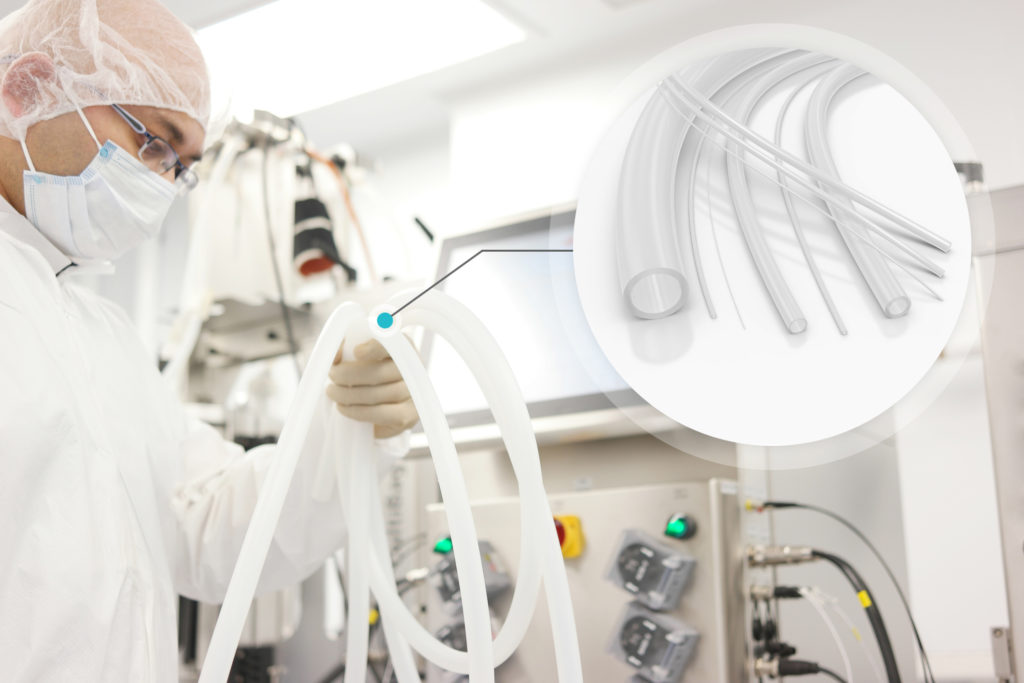To Issue 136
Citation: Lowe J, “Single Use Systems – the Future of Biopharmaceutical Processing”. ONdrugDelivery, Issue 136 (Aug 2022), pp 54–56.
Jeff Lowe considers single-use systems and looks at their role in the future of biopharmaceutical processing.
Based on an article that originally appeared in Medical Design Briefs in February 2022.
“Both stainless steel systems and the reusable parts of disposable systems contain an inherent risk of contamination unless cleaning and sterilisation regimes are thoroughly performed.”
Single-use systems (SUS) represent the future in biopharmaceutical processing of therapeutic drugs with significant advantages over traditional reusable stainless steel systems.
Seemingly the antithesis to a whole world trying to move away from disposable products and processes, SUS actually promote sustainability by eradicating the chemicals and resources, such as water and energy, needed to sterilise reusable systems. Perhaps, most critically, with little cost and process time, SUS virtually eliminate the risk of cross-contamination, as the product flow path is discarded and replaced after each batch.
MANUFACTURING PROCESS SYSTEMS
Within the biopharmaceutical industry, three types of processing systems are used to create therapeutic drugs.
The first type involves stainless steel systems. These are reusable, durable and able to withstand exposure to the chemicals used to sanitise pharmaceutical processing systems, usually at extreme temperatures. These require stringent sterilisation regimes that involve harsh chemicals and require considerable energy consumption to bring systems up to the extreme temperatures required for effective cleaning.
The second types are partly disposable systems. These use some parts of the processing system more than once, depending on the therapeutic being produced. Reused parts undergo cleaning regimes similar to those used to sterilise stainless steel systems, and maintenance is required as reusable elements deteriorate over time.
Both stainless steel systems and the reusable parts of disposable systems contain an inherent risk of contamination unless cleaning and sterilisation regimes are thoroughly performed.
SUS, the third type of biopharmaceutical processing system, are designed to be used for the duration of the production process of a single batch of therapeutics and then discarded.
The rise in the adoption of single-use technologies is proving to reduce product cross-contamination risks. In addition, SUS are highly efficient and cost-effective. According to a study conducted by Single Use Support (Endach, Austria), SUS lower operating costs by offering 46% water and energy requirement reductions, a 35% more favourable CO2 footprint due to lower facility emissions and a 40% lower initial investment cost. They also allow pharmaceutical manufacturers to push products to market faster by increasing throughput and making scalability easier.
THE SHIFT TO SINGLE-USE SYSTEMS
Single-use bioprocessing systems have gained significant traction due to the rapid adoption of disposable technology by pharmaceutical manufacturers. According to Allied Market Research, the value of the global single-use bioprocessing market was US$2.8 billion (£2.4 billion) in 2016, and the projection is for it to reach $9.3 billion by 2023, at a CAGR of 18.7% over the period.
BOX 1: A BRIEF HISTORY OF TRADITIONAL
VERSUS THERAPEUTIC DRUGS
Synthesised and made from chemicals, traditional drugs, such as aspirin, process and attach to a certain gene. mAbs are laboratory-made proteins that mimic the immune system’s ability to fight off harmful antigens, such as viruses.
Therapeutic drugs made in biopharmaceutical processing using mAbs teach the human immune system how to protect itself if introduced to a disease or illness.
Biopharmaceuticals include a wide range of products, such as vaccines, therapeutic proteins, blood and blood components and tissues. In contrast to chemically synthesised small-molecule drugs, which have a well-defined structure, biopharmaceuticals derive from living materials (human, animal, micro-organism or plant) and are much larger and more complex in structure.
Because biopharmaceuticals work with the immune system and do not contain chemical-based drugs, there is greater acceptance of biopharmaceuticals to treat a range of diseases, and the market is growing quickly. In addition, an increasing ageing population in Western countries, rising costs of healthcare globally, widespread presence of chronic ailments, technological advancements and manufacturing and contamination factors are all driving the rise in biopharmaceutical market demand.
The biopharmaceutical method of making drugs is an especially high-profile topic due to the global covid-19 pandemic and the use of the mRNA vaccine, which is made using a biopharmaceutical process.
The technology is primarily applied in disposable freezing of pharmaceuticals, sterile filling of drugs, transportation of drug products, culture media preparation andbuffer preparation for bioprocessing. Most biopharmaceutical companies therefore use SUS to manufacture vaccines using large-scale bioreactor bags (Box 1), monoclonal antibodies (mAbs) and other pharmaceutical components on a commercial scale (Figure 1).

Figure 1: In SUS, all process parts are replaced with a new set so the system is quickly back up and running.
However, there are challenges in developing SUS relating to gaining regulatory approval of component materials, navigating the nuances of material compatibility with process fluids and maintaining the supply chain. For these reasons, suppliers must provide assurance that their products deploy operational best practices and are certifiably and regulatorily safe.
“In SUS, all process parts, including hoses, bags and seals, are disposed of and replaced with a new set so the system is quickly back up and running.”
VALUE OF QUALITY AND MATERIAL EXPERTISE
One major advantage of SUS is single approval. Traditionally, after pharmaceutical manufacturers produce a batch of drugs, they must sterilise all the equipment and submit the equipment to the US FDA for approval between batches. This is a very costly and time-consuming process. Everything must be sterilised, and the seals in equipment connections often need to be replaced. Companies incur labour and supply costs when sanitising the system and experience extended downtime during cleaning.
In SUS, all process parts, including hoses, bags and seals, are disposed of and replaced with a new set so the system is quickly back up and running. Pharmaceutical manufacturers only need to gain approval from the FDA once. This not only saves time and money but also involves less risk of contamination and generates greater throughput.
A trusted and experienced supply partner can provide therapeutic manufacturers with all the data needed to support the quality of the component materials and parts for approval by the FDA. This may include the production of parts in a cleanroom and independent laboratory testing.
While there are no industry standards specifically for SUS, components, including seals, should comply with certain standards and technical guides. Some specific examples are the ASTM Standard F838-05 on Sterilizing Filtration, the ANSI/AAMI/ISO Standard 11137 on Sterilization of Healthcare Products – Radiation, and the ANSI/AAMI/ISO Standard 13408 on Aseptic Processing of Healthcare Products.
The Bio-Process Systems Alliance (BPSA) is a leader in developing new best practice guides for SUS. This is stimulating the development of standards and guides by other organisations, such as ASTMBPE, PDA and ISPE. BPSA guides cover irradiation and sterilisation validation, determination of extractables and leachables and disposal of SUS.
EXTRACTABLES AND LEACHABLES
To select processing materials that avoid risk, it is important to understand the chemical nature of extractables and leachables. Extractables are compounds emitted from a packaging component, delivery system or manufacturing surface during aggressive testing. Leachables are compounds that migrate into the drug over time from contact with system components and manufacturing surfaces.
An interaction of extractables or leachables with drugs or other media can be harmful to individuals and have possible long-term effects on the human body. Thorough testing is required to ensure that products are suitable for high-risk applications, such as drug delivery devices, combination products and long-term implants. For example, extensive testing must be conducted with all components to determine the extraction levels of substances under different conditions (Figure 2).

Figure 2: SUS have significant advantages over traditional reusable stainless steel systems.
CONCLUSION
Single-use bioprocessing technology has gained significant traction due to the rapid adoption of disposable bioprocessing equipment by pharmaceutical manufacturers. SUS help pharmaceutical manufacturers save time and money while minimising the risk of contamination. Additionally, pharmaceutical manufacturers can select processing materials that limit extractables and leachables and rest assured that they meet all regulations by partnering with an experienced components supplier.
By monitoring the market and staying in tune with customer needs, components suppliers can help therapeutic manufactures choose the right material for the right application. When components suppliers have global reach and material development expertise, they can demonstrate a comprehensive understanding of product applications. This allows them to collaborate with therapeutic manufacturers to understand their needs and provide the best solution.
Previous article
DISSECTING THE DELICATE DELIVERY PROCESS FOR OCULAR GENE THERAPYNext article
CONTINUOUS IMPROVEMENT: FROM ABSTRACTION TO REALITY
